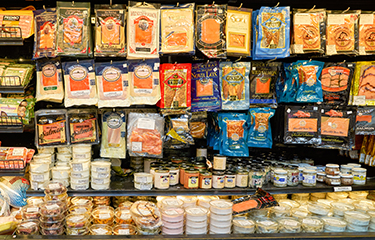U.S. fresh and frozen seafood sales and volume declined more than retail data predicted in August, despite continued deflation.
Fresh seafood sales plunged 7.4 percent in August to USD 595 million (EUR 566 million), while fresh seafood volume decreased 6.6 percent. Frozen seafood sales dropped 7.7 percent to USD 619 million (EUR 579 million), while volume in the category fell 8.1 percent.
Even though shelf-stable seafood sales jumped 1.9 percent, with its volume increasing 2.7 percent, many experts, including 210 Analytics Principal Anne-Marie Roerink, were surprised at the low sales totals. Though Roerink couldn’t pinpoint exactly why the August numbers were lower than expected, she said many Americans dined out more during the month.
A consumer survey from Lakeland, Florida, U.S.A.-based 210 Analytics revealed that August had the lowest estimated share of meals cooked at home nationally – at 76.8 percent – since March 2020.
One cause for that trend was that menu prices continued to decline in August, according to new data from the U.S. Bureau of Labor Statistics. The Consumer Price Index (CPI) for food away from home increased 6.5 percent between August 2022 and August 2023, which was the smallest 12-month increase since January 2022.
“The recent moderation was a significant departure from a year-long period of double-digit gains – including a peak increase of 13.5 percent in August 2022,” National Restaurant Association Chief Economist Bruce Grindy said in a statement.
With consumers eating out more, retailers suffered from a drop in seafood sales, but this came amid a drop in prices that reflected below-average inflation across the board. Seafood prices were actually lower in August 2023 than in August 2022, according to Roerink. Fresh seafood prices dropped 0.9 percent in August, and shelf-stable seafood prices dropped 0.8 percent. Fresh shellfish had the deepest cuts in price, experiencing 3.6 percent deflation, according to new Circana data provided by 210 Analytics.
Frozen seafood prices rose but only at 0.5 percent in August, much less than in previous months – and all categories showed “very favorable conditions to consumers,” Roerink said. Though prices for several types of seafood became more consumer-friendly in August, the trend didn’t lead to increased sales, she said.
Fresh crab was the most notable example, with a price drop of 17.5 percent compared to last August but a 6.5 percent slide in sales by value, though sales by volume increased 13.5 percent for the month.
On the other side of the equation, fresh lobster prices spiked 17.6 percent, resulting in a 13.5 percent decrease in sales by value and a 26.4 percent decline in sales by volume.
Salmon prices have declined significantly in recent months, and that carried over into the U.S. retail sector, which saw a 0.7 percent increase in fresh prices and a 1.9 percent price decline for frozen salmon in August, according to Roerink. However, the overall price reductions were not enough to avoid a drop in sales, as fresh salmon sales dropped 4.1 percent by value and 4.8 percent by volume in August ...
Photo courtesy of Sorbis/Shutterstock








